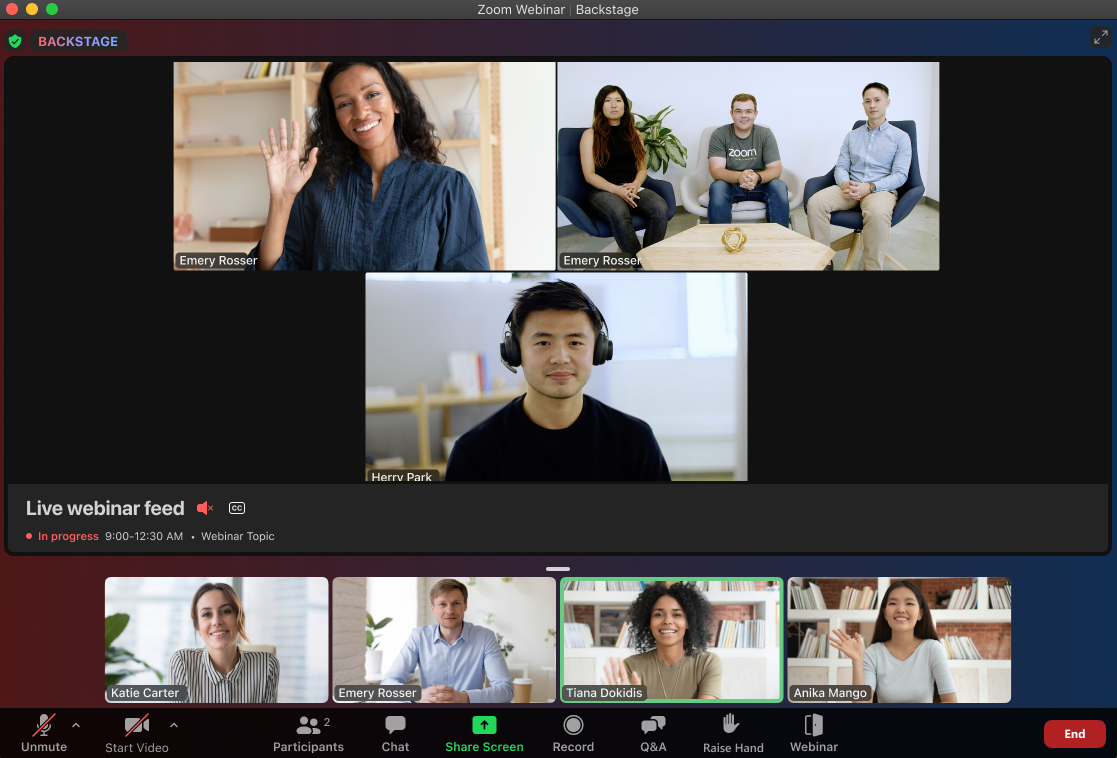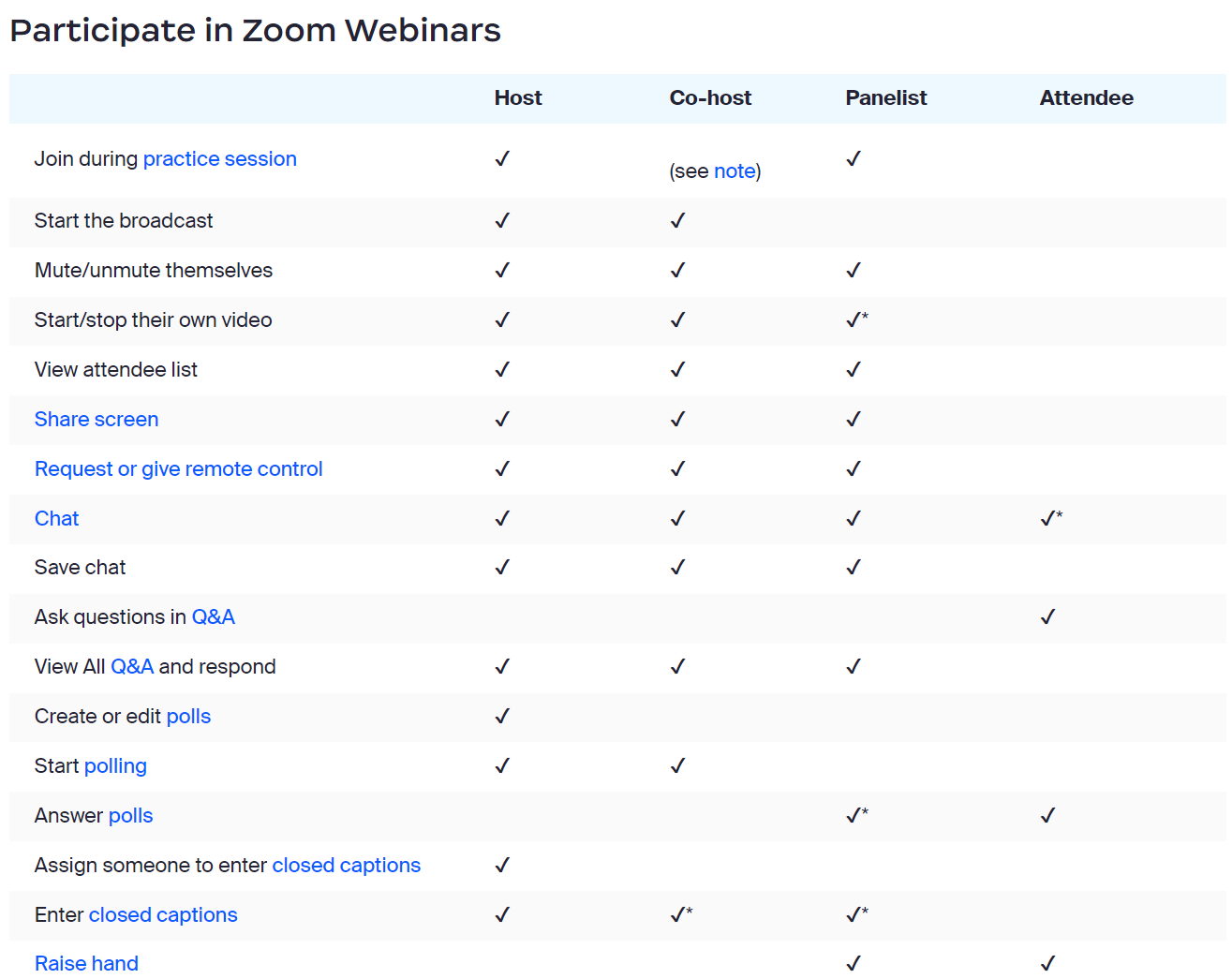What is a Zoom Webinar and How to Use It
August 13, 2024
August 13, 2024
November 19, 2025
November 19, 2025
Virtual events have become indispensable for businesses. Zoom Webinars offer a robust platform for hosting these events, providing a structured and professional environment that facilitates large-scale presentations and audience engagement.
This guide delves into Zoom Webinars, highlighting their unique features, setup processes, and practical applications. Whether you're aiming to host a product launch or a training session, understanding how to use Zoom Webinars can enhance your event's success and reach. It is also important to test Zoom to ensure your events run smoothly and professionally.
What is a Zoom Webinar?

Image from Zoom
A Zoom Webinar is an online event where a host and panelists present to an audience. Unlike a regular Zoom meeting, attendees have limited interaction capabilities. They can watch and listen but can't share their screens or speak unless given permission.
Differences Between Zoom Webinars vs Meetings
- Audience Size: A Zoom Webinar can host up to 10,000 attendees, whereas a Zoom meeting typically accommodate fewer participants.
- Interaction: In a Zoom meeting, everyone can speak, share screens, and see each other. In webinars, only the host and panelists can do these things.
- Control: Webinars give the host more control over the event, including muting attendees and managing questions.
Key Features and Benefits
- Q&A and Polling: Engage your audience with Q&A sessions and polls.
- Registration: Collect attendee information through customizable registration forms.
- Reporting: Access detailed reports on attendance and engagement.
- Recording: Record your webinar for future viewing or sharing.
Understanding these aspects of Zoom Webinars can help you determine if they're the right tool for your online events.
Why Choose Zoom Webinars for Your Events?
Cost-Effectiveness and Accessibility
Zoom Webinars offer a cost-effective solution for hosting large events online–a virtual lecture hall. You don't need to rent a physical venue, which saves money on space, travel, and catering. Plus, with the ability to host up to 10,000 attendees, you can reach a much larger audience without additional costs.
Scalability for Large Audiences
Zoom Webinars are designed to scale easily. Whether you're hosting a small workshop or a large conference, Zoom can handle it. You can start with a smaller audience and scale up as needed without changing platforms.
Enhanced Engagement Through Video, Audio, and Screen Sharing
Zoom Webinars come with features that enhance audience engagement. Use video and audio to create more interactive sessions. Screen sharing allows you to present slides, videos, and other content directly to your audience.
Integration with Other Tools and Platforms
Zoom Webinars integrate seamlessly with other tools and platforms. You can connect with CRM systems, email marketing tools, and social media platforms. This makes it easier to manage registrations, send reminders, and follow up with attendees after the event.
Choosing Zoom Webinars for your events provides a range of benefits, making it a versatile and practical choice for businesses and educators alike.
How to Set Up a Zoom Webinar
Setting up a Zoom Webinar might seem overwhelming, but it's straightforward once you break it down. Follow these steps to ensure your webinar runs smoothly.
Scheduling a Webinar: Date, Time, and Settings

- Log in to the Zoom web portal: Navigate to the "Webinars" section in the main menu.
- Click "Schedule a Webinar": Enter your webinar's details including the title, description, and the presenter’s names.
- Set the date and time: Choose when your webinar will take place. Pay attention to time zones if you have international attendees.
- Adjust the settings: Choose whether to allow practice sessions, enable Q&A, and decide if you want to record the webinar automatically.
Customizing Registration Options and Confirmation Emails
- Enable registration: Decide if you want attendees to register in advance. This helps you gather information and track attendance.
- Customize the registration form: Add fields to collect necessary information such as name, email, and any specific questions you want to ask.
- Set up automatic or manual approval: Choose whether registrants are approved automatically or if you want to manually review each registration.
- Edit confirmation emails: Customize the confirmation email that attendees receive upon registration. Ensure the email design is clean and engaging, and include essential details like the webinar link, date, and time for easy reference.
Inviting Panelists and Attendees
- Send panelist invitations: Go to the "Invitations" tab, click "Edit" in the panelists' section, and enter their names and email addresses. They will receive a unique link to join as panelists.
- Invite attendees: Share the registration link or the direct join link if you’re not requiring registration. Use email, social media, or your website to spread the word.
- Set roles and permissions: Assign roles to panelists and co-hosts, ensuring they have the necessary permissions to share their screen, speak, and manage attendees.
Setting Up Webinar Branding and Reminders
- Brand your webinar: Customize the registration page with your logo, colors, and banner image. This creates a cohesive and professional look.
- Set up email reminders: Schedule reminder emails to be sent to registrants a day or an hour before the webinar starts. Include the join link and any last-minute instructions.
- Prepare your materials: Ensure all presentations, videos, and other materials are ready and tested. Upload any necessary documents in advance.
By following these steps, you'll be well on your way to hosting a successful webinar. Each step ensures that your Zoom event is well-organized, engaging, and professional.
What to Expect During a Zoom Webinar
Joining as a Host, Panelist, or Attendee

Understanding the different roles in a Zoom Webinar is crucial. Each role—host, panelist, and attendee—has unique functions and permissions.
- Host: The host is responsible for starting and ending the webinar, managing settings, and monitoring the event. To join as a host:
- Log in to Zoom: Go to the "Webinars" section.
- Click "Start": Find your scheduled webinar and click "Start" to begin the session.
- Manage the event: You can control audio settings, manage Q&A, and oversee the chat.
- Panelist: Panelists are the presenters who can share video, audio, and their screen.
- Receive a unique link: Panelists get a special invitation link.
- Join the webinar: Click the link to enter the webinar as a panelist.
- Participate actively: Share content, answer questions, and engage with attendees.
- Attendee: Attendees primarily observe and can interact through Q&A and chat.
- Register or join via link: Depending on the setup, attendees either register in advance or join directly through a link.
- Engage with the content: Use chat to interact and Q&A to ask questions.
Managing Attendee Interactions and Q&A Sessions
Effective management of attendee interactions keeps your webinar engaging and orderly.
- Q&A sessions: Enable the Q&A feature for structured questions.
- Monitor questions: Hosts and panelists can see and respond to questions in real-time.
- Moderate effectively: Choose to display answered questions to all attendees or keep them private.
- Chat function: Allows for broader interaction.
- Enable chat: Decide if attendees can chat with everyone or only hosts and panelists.
- Monitor chat: Keep an eye on the chat to address any issues or important comments.
Utilizing Advanced Features - Polling, Chat and Annotation
Polls and chat features enhance interaction and engagement during your webinar.
- Polling: Create interactive polls to gather instant feedback or quiz attendees.
- Prepare polls in advance: Set up your polls before the webinar starts.
- Launch during the webinar: Use polls to break the monotony and engage the audience.
- Chat: Foster real-time interaction.
- Encourage audience participation: Prompt attendees to use the chat for comments or feedback.
- Monitor chat activity: Assign a panelist or co-host to oversee the chat.
- Annotation:
- Annotation in Zoom allows you to draw, write, or highlight directly on shared screens or whiteboards during a meeting. This feature helps make presentations more interactive and engaging by allowing participants to visually emphasize points.
Recording and Live Streaming Options
Recording and live streaming expand the reach of your webinar and provide content for future use.
- Recording: Save your webinar for later viewing.
- Enable automatic recording: Set your webinar to record automatically.
- Access recordings: Find recordings in your Zoom account after the webinar ends.
- Live streaming: Broadcast your webinar to a broader audience.
- Stream to platforms: Choose to live stream on platforms like Facebook Live or YouTube.
- Set up in advance: Ensure your streaming settings are configured before the webinar starts.
By understanding these aspects, you can ensure a seamless and engaging experience for all participants during your Zoom Webinar.
Common Questions About Zoom Webinars
When you join a Zoom webinar, is your camera on?
When you join a Zoom webinar as an attendee, your camera is off by default. This setup helps maintain privacy and reduces potential distractions.
Camera and Microphone Settings for Attendees:
- Camera Off: Attendees join with cameras off and cannot turn them on unless promoted to panelists.
- Microphone Muted: Attendees' microphones are also muted by default. They can only unmute if the host allows it.
Does a Zoom Webinar show your face?
In a Zoom Webinar, the faces of attendees are not shown unless they are promoted to panelists. Hosts and panelists, however, can share their video.
Video Sharing Capabilities:
- Hosts and Panelists: Can turn their video on and off at any time.
- Attendees: Cannot share their video. They remain in a "view-only" mode unless given special permissions by the host.
Can attendees at Zoom Webinar hear you?
In a Zoom Webinar, attendees' microphones are muted by default. This ensures that only the hosts and panelists can be heard unless specific permissions are granted.
Audio Settings and Interaction Controls for Attendees:
- Muted Microphones: Attendees join in a muted state. They can only speak if unmuted by the host.
- Interaction Methods: Attendees can interact using Q&A, chat, and polls instead of speaking.
Zoom Webinars offer a structured and controlled environment, making them ideal for large presentations and events. Understanding the basic functionalities and settings helps ensure a smooth experience for both hosts and attendees. By managing video and audio permissions effectively, webinars maintain focus and minimize disruptions.
Tips for Hosting Successful Zoom Webinars
Preparing Your Presentation and Materials
To host webinars, thorough preparation is key. Here are essential steps to get ready:
- Outline Your Content: Create a clear and logical structure for your presentation. This ensures your message is coherent and engaging.
- Design Visually Appealing Slides: Use high-quality images, readable fonts, and concise text. Tools like PowerPoint or Google Slides can help you create professional slides.
- Rehearse: Practice delivering your presentation multiple times. This helps you become familiar with the flow and timing, reducing the risk of errors during the live event.
- Backup Materials: Have backup copies of your slides and any other materials. Store them in different locations, such as a USB drive and cloud storage.
Engaging Your Audience with Interactive Elements
Keeping your audience engaged is crucial for the success of your webinar. Here are some techniques:
- Q&A Sessions: Allow time for questions from the audience. This leads to more interactive sessions.
- Polls and Surveys: Use Zoom's polling feature to gather real-time feedback and keep the audience engaged.
- Chat Interaction: Encourage attendees to use the chat feature to share their thoughts and questions. Assign a co-host to monitor and respond to chat messages.
- Breakout Rooms: For smaller, interactive discussions, use breakout rooms to divide attendees into smaller groups.
Managing Technical Aspects and Troubleshooting
Technical issues can disrupt your webinar. Here’s how to manage and troubleshoot them effectively:
- Check Equipment: Ensure your camera, microphone, and internet connection are working properly before the webinar starts.
- Update Software: Keep your Zoom client and any other software up to date to avoid compatibility issues.
- Test Run: Conduct a full test run with all equipment, including any interactive elements like polls and screen sharing.
- Have a Tech Support Plan: Assign a team member to handle technical issues. Have contact information for Zoom support readily available.
Post-Webinar Follow-Ups and Feedback Collection
After the webinar, follow up with attendees to keep the engagement going and gather valuable feedback:
- Send Thank-You Emails: Express gratitude to attendees for their participation. Include a summary of key points and a link to the recorded webinar.
- Feedback Forms: Distribute a survey to gather feedback on the webinar’s content, delivery, and technical aspects. Use tools like Google Forms or SurveyMonkey.
- Provide Additional Resources: Share articles, additional videos, or related content that attendees might find useful.
- Analyze Feedback: Review the collected feedback to identify areas for improvement for future webinars.
Proper preparation, engagement techniques, technical management, and post-webinar follow-ups are crucial for hosting successful Zoom Webinars. These steps ensure that your event runs smoothly and leaves a lasting positive impression on your audience.
{{rt_cta_ai-convenience}}
How Tactiq Enhances Your Zoom Webinars

If you’re looking to enhance your current Zoom webinar setup, use Tactiq. It provides live transcriptions, AI-generated summaries, and new features like AI meeting kits and prompts. Here’s how it can improve your experience:
- Live Transcriptions and AI Summaries: Tactiq provides live transcriptions and generates AI summaries during webinars, ensuring you capture key points without manual note-taking.
- AI Meeting Kits and Prompts: Tactiq offers AI meeting kits and customizable prompts to streamline follow-up tasks, making your workflow more efficient.
- Post-Webinar Follow-Up: The tool’s AI-powered assistant creates detailed summaries and follow-up emails, reducing the time and effort needed for post-webinar tasks.
- Seamless Integration: Tactiq integrates with Zoom, Google Meet, MS Teams, and other productivity tools, automating follow-up activities with reusable one-click actions, ensuring you maximize your webinar productivity.
Tactiq's features make your Zoom Webinars more accessible, engaging, and efficient, ensuring a seamless experience for both presenters and attendees.
Zoom Webinars let you present to large audiences—up to 10,000 attendees—while keeping control over who can speak or share their screen. You benefit from a more structured, distraction-free environment, so your presentations stay focused and professional.
Schedule your webinar by choosing the date, time, and settings, then customize registration forms and confirmation emails. Invite panelists and attendees, brand your event page, and set up reminders so your audience is informed and engaged from the start.
You can use Q&A sessions, polls, chat, and annotation tools to keep your audience involved. These features help you gather feedback, answer questions in real time, and make your presentations more dynamic and memorable.
Tactiq provides live transcriptions and AI-generated summaries, so you never miss key points and can skip manual note-taking. Its AI meeting kits and follow-up tools automate post-webinar tasks, saving you time and making your workflow more efficient.
Prepare your content and materials, rehearse your presentation, and test your tech before going live. During the webinar, use interactive elements to engage attendees, and after the event, send thank-you emails, collect feedback, and share resources to keep your audience connected.
Want the convenience of AI summaries?
Try Tactiq for your upcoming meeting.
Want the convenience of AI summaries?
Try Tactiq for your upcoming meeting.
Want the convenience of AI summaries?
Try Tactiq for your upcoming meeting.









